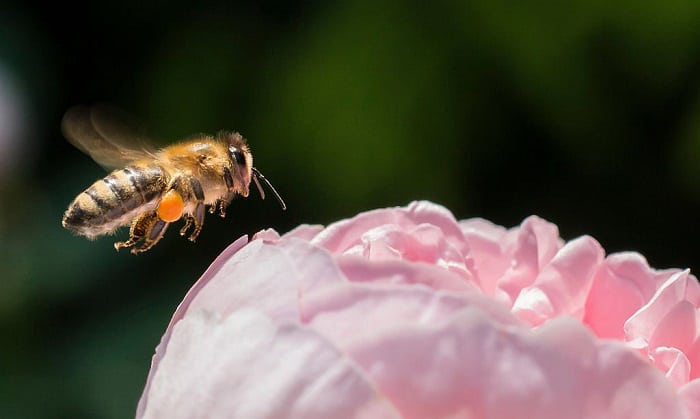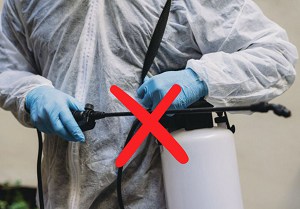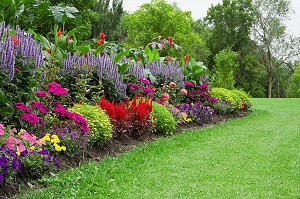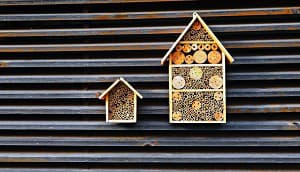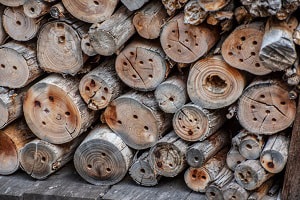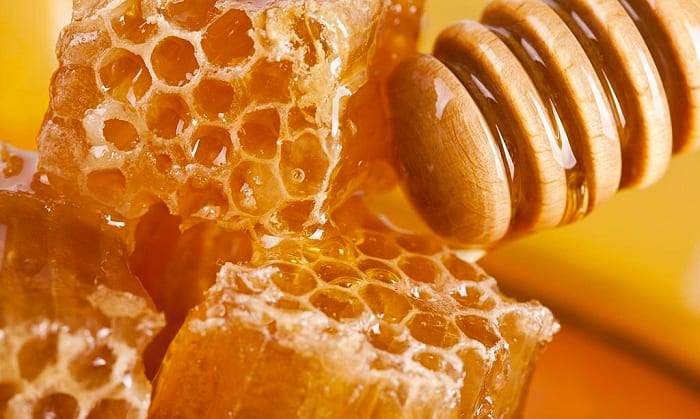If you’re a gardener or farmer, you likely know the importance of pollination. Without this process, plants won’t produce enough seeds, and many fruits and vegetables we consume will cease to exist.
In fact, over a thousand crop types require pollination, so it’s a huge help to know how to attract bees to your garden. In short, you should avoid pesticides, plant flowers of the right species and colors, and install a bee house, among other methods.
Table of Contents
Ways to Attract Bees to Your Garden
1. Avoid pesticides
Many people use pesticides to eliminate species that eat or harm plants. Unfortunately, pesticides, specifically insecticides, can kill bees.
In fact, products with neonicotinoids (namely, clothianidin, thiamethoxam, and imidacloprid) and fipronil can harm bees in the garden.
Hence, it’s crucial not to use these substances altogether. If you must use pesticides, check the labels carefully before purchasing.
At the same time, follow the tips below:
- Limit pesticide applications to evenings when bees are not active.
- Do not use dust and wettable powder insecticides. These will stick to bees easily and kill them.
- Choose chemicals that lose potency in a few hours rather than a few days or weeks.
- Spray insecticides by hand if possible, and avoid using planes to distribute the substances, especially on windy days. Otherwise, the pesticide may get on bees by accident.
2. Use the right plants
Choose native plants
To attract honey bees that are specific to your region, it’s essential to have native plants in your gardens. Bees are used to such flora and are more drawn to them.
Of course, native plants differ by region, so look up the flowers and trees that naturally grow in your city or state. You can consult the website of the Xerces Society for this.
Below is a short list of native plants in the US, sorted by region:
- California – Lady phacelia, California poppy, Cleveland sage, common sunflower, California fuchsia, Oregon grape, silver bush lupine, California buckwheat.
- Florida – Dotted horsemint, butterfly milkweed, blue mistflower, seaside goldenrod, eastern redbud, sparkleberry, buttonbush, Flatwoods plum.
- Northern Plains (Wyoming, Nebraska, etc.) – American vetch, purple prairie clover, wild bergamot, Maximilian sunflower, chokecherry.
- Southeast region (Alabama, Kentucky, Tennessee, etc.) – Eastern smooth penstemon, eastern rosemallow, cockspur hawthorn, pasture rose, maypop.
- Northeast region – Wild geranium, blue vervain, field thistle, calico aster, raspberry, ninebark, New Jersey tea.
- Albuquerque and Santa Fe – Pale evening primrose, bee balm, gayfeather, Apache plume, desert willow.
- Great Lakes region – Wild lupine, dotted mint, wingstem, bottle gentian, leadplant.
- Maritime Northwest region – Common camas, selfheal, Puget Sound gumweed, Nootka rose, Douglas spiraea, coyote brush.
- Midwest region – Wild geranium, smooth penstemon, yellow giant hyssop, wingstem, prairie willow.
- Southern Plains region – Prairie penstemon, lemon beebalm, dotted blazing star, aromatic aster, chickasaw plum.
- Mid-Atlantic region – Lanceleaf coreopsis, mountain mint, New England aster, Sneezeweed, pussy willow, basswood.
Choose the right flower colors.
What are bees attracted to? The answer to this question is “blue, purple, yellow, violet, and white flowers.” Many of the plants we listed above produce blooms with these shades, so you can take advantage of both this tip and the previous one.
It’s also best to have a variety of flowers and place them close together. This practice will save you garden space. Plus, an abundance of blossoms will stand out more to bees.
Have different flower shapes
Different bee species will favor different flower shapes for pollination.
For example, long-tongued bumblebees like flowers with deep tubes like monkshoods, but not small, flat blossoms like Angelica flowers.
Another example is honeybees, which will not fertilize buzz-pollinate plants like borage but collect nectar from open, bowl-shaped buttercups and shrub roses.
These are some reasons it’s recommended to have a variety of flowers in your yard. In general, flora with a single petal is the best.
3. Grow plants year-round
Because bees are active most of the year and stay in their hives during winter, your garden should be flourishing with flowers from March to September.
As long as this is the case, honey, carpenter, and bumble bees will come to your yard from spring to fall.
If you want to attract specific species of pollinators, look up when they’re active as well. For example, Southeastern blueberry bees will only appear when blueberries are flowering.
4. Set up a bee house
Another method for attracting bees to garden is to give them shelter. You can do this by setting up a bee house.
- Choose commercial products made of breathable materials, and avoid bamboo. This ensures the bee house can dry more easily and is less susceptible to mites.
- Secure the house so it doesn’t fall due to winds. If the house is stable, bees will also land inside it effortlessly.
- You should clean the bees’ nests after they have left. Think of the bee house like your room. If it never gets sanitized, it will eventually become inhabitable.
- The house is reserved for bee pollinators in your garden. Therefore, it’s important to keep birds from taking over the structure. You can use metal netting for this.
- Small bee houses are easier to maintain.
- Pick a product with an overhang so rain doesn’t get inside it. The nesting hole should be 6 inches long and 4 to 10 mm big.
- Bee houses should face the sun since these insects need to stay warm.
5. Place wood piles in your garden
For this method, you’ll need:
- Wood pieces
- Drill
Steps to follow:
- Step 1: First, find a few logs and put them in your yard.
- Step 2: Then, drill holes of different sizes into the logs, and place the lumber pieces upright on the ground. The holes are where the bees will nest.
- Step 3: Holes with a ⅚ inch diameter, for example, will attract orchard mason bees.
- Tip: In addition to using logs, you should also put a basin of clean water in your garden and leave an area of the ground mulch-free. These measures will make your lawn more alluring to bees.
Can I Attract Bees With Honey?
Bees are attracted to honey and can even smell it. If you leave this substance out in the open, these creatures may find it and eat it.
Now, you may think you can use bee attraction to honey to get them into your garden. However, it’s not wise to carry out this method.
Honey from supermarkets can cause infections in these pollinators. Moreover, if you’re not an apiarist, you won’t know how or what to feed bees, so it’s best not to risk their well-being.
Can I Supply Bees With Sugar Water?
Suppose the bees have built their own hive in your garden, and you wonder whether you should feed them sugar water to encourage their growth.
In general, you should do so only if it’s winter and the bees have nearly no food for themselves. However, there are a few things to keep in mind:
- Feeding bees sugar syrup means they may not pollinate your plants, as there would be no need for these creatures to find sustenance anymore.
- The sugar water may attract too many bees, and while you want them in your garden, an excess of these insects is probably unpleasant.
- If you’re not an apiarist, it’s best not to feed bees. You’ll have to wonder which sugar type to use (the answer is white sugar) and think about the ratio of sugar to water (the ratio is 1:1).
Last but not least, if the bees are passing away, feeding them is useless, and you’ll likely get stung.
Conclusion
How to attract bees to your garden? If you try one or several of the methods we described, you won’t have to worry about your plants not growing due to lack of fertilization.
Plus, there will be no need to use self-pollinating fruits or rent a bee colony. If you liked this article, please share it with other people. Thanks for reading!
Furthermore, I would like to recommend to you some solutions that protect your garden from insects and animals. Please take a look at these articles:
- 6 effective methods to kill ants in vegetable garden
- 5 easy ways to get rid of stink bugs in the garden
- Keep chickens out of flower beds – 9 effective methods

Hi, I am William – Floridayards’ digital content creator. My job is to find answers to all your concerns with thorough research and our team’s expert advice. I will also bring you honest reviews on the best products and equipment for raising your beautiful garden. Please look forward to our work!


